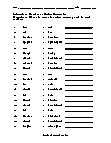Number Properties Worksheets
What Are the Commutative, Associative, and Distributive Properties of Numbers? The commutative, associative and distributive properties are the underlying laws of algebra. They are first taught in early years in simpler and broader terms. Teaching these properties in early years gives a firm foundation to the children, which later on help them in understanding the advanced concepts. Here we have elaborated on the three properties of numbers. Commutative Property - Commutative is derived from the word commute, which means to move around. The commutative property means moving the numbers around within the number sentence. In algebraic terms, this commutative property implies being able to move the variables around. The equation of commutative property of addition defines: a + b = b + a, 3 + 4 = 4 + 3. The equation of the commutative property of multiplication defines: a x b = b x a, 3 x 4 = 4 x 3. Associative Property - The associative property is derived from the word associate or group. It means the grouping of variables and numbers. You can regroup or rearrange the variables in the number sentence but still, get the same answer. The equation of associative property of addition says: (a + b) + c = a + (b + c), (4 + 2) + 1 = 4 + (2 + 1). The equation of associative property of multiplication says: (a x b) x c = a x (b x c), (4 x 2) x 1 = 4 x (2 x 1). Distributive Property - Distributive property allows you to eliminate the brackets in the number expression. Multiply the values outside the parenthesis with each term present in the brackets. The equation of distributive property can be written as: a x (b + c) = a x b + a x c.
-
Basic Lesson
Demonstrates the commutative, associative, and distributive properties. Identify the property in the equation. Practice problems are provided.
View worksheet -
Intermediate Lesson
Explains how to the property displayed in an equation. Practice problems are provided. Identify the property in the equation. z (d-c) = zd – zc.
View worksheet -
Independent Practice 1
Write the name the number property used in each problem. The answers can be found below.
View worksheet -
Homework Worksheet
12 Number Properties problems for students to work on at home. Example problems are provided and explained.
View worksheet
Who Was Babbage?
Charles Babbage was the mathematician whose concepts back in 1812 spearheaded the modern computer. His computation of logarithms made him aware of the inaccuracy of human calculations, which changed the whole of mathematics and the world!







